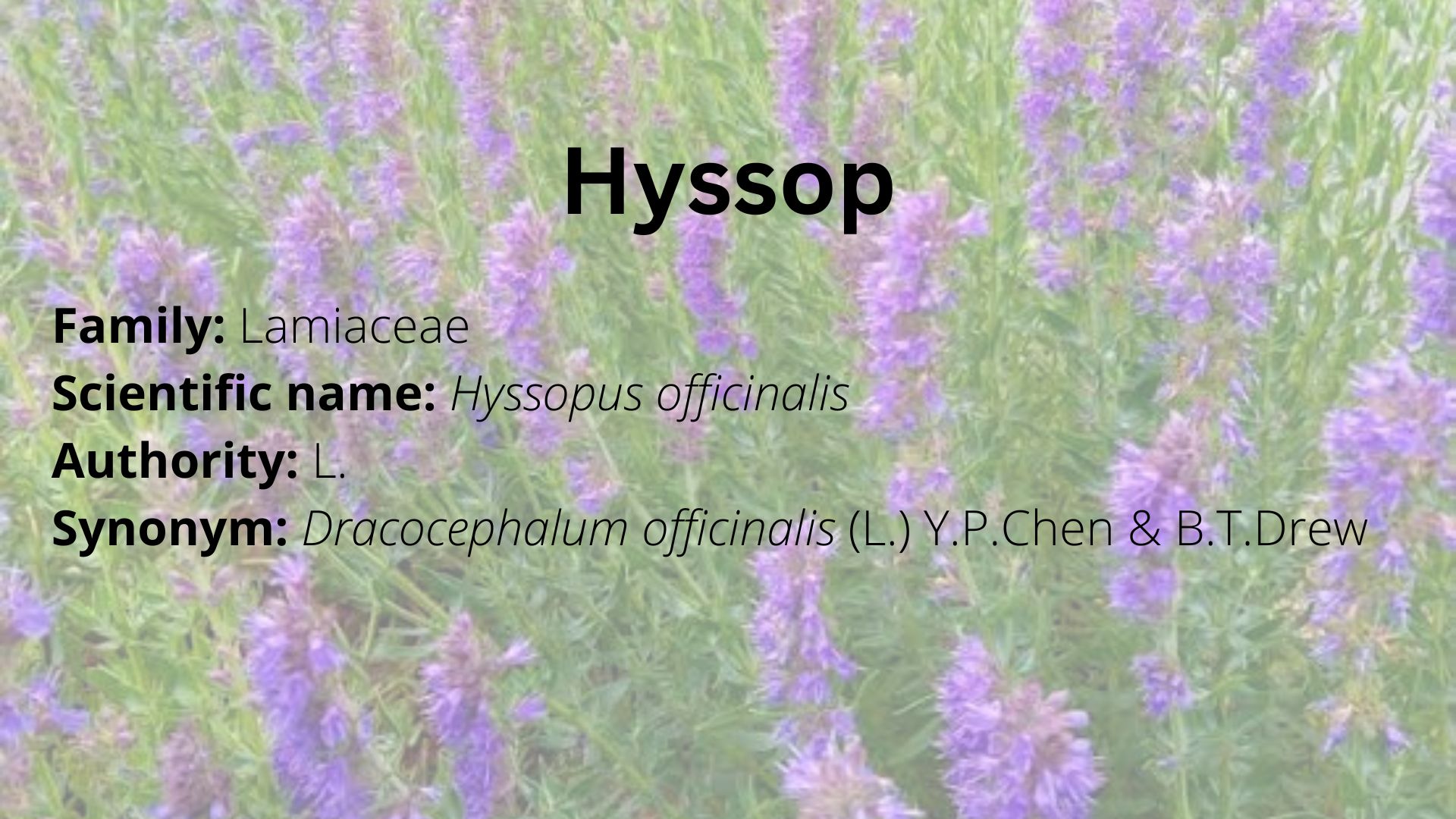Family: Lamiaceae
Scientific name: Hyssopus officinalis
Authority: L.
Synonym: Dracocephalum officinalis (L.) Y.P.Chen & B.T.Drew
Common name: hyssop
Description: H. officinalis is an aromatic perennial herb or subshrub that is mainly cultivated but can also grow in the wild. It has opposite lance-shaped leaves, scented pinkish-bluish flowers in a false spikelike inflorescence, and small four-sided achenes.
The plant is bitter, dry, pungent, and slightly warming.
In Psalm 51:7 of the Bible, King David pleaded with God for cleansing with hyssop – “Purge me with hyssop, and I shall be clean: Wash me, and I shall be whiter than snow.“
The name hyssop is derived from the Greek word azob, which means holy herb.
Uses:
Historically, the plant was prescribed by Hippocrates (a Greek physician) for treating pleurisy and recommended by Dioscorides (a Greek physician and pharmacologist) for asthma and catarrh.
- The plant is used for religious purification.
- The vapour of the plant is believed to drive away the winde that is in the ear.
- The leaves are used as a minty flavour, condiment and spice in food.
- The plant is used to add flavour to alcoholic drinks.
- The plant is used as an antiseptic, carminative, and expectorant agent. The aerial parts are used as an expectorant in asthma, bronchitis, chesty colds. The aerial parts also ease flatulence and soothe griping pains.
- The plant is mixed with figs for constipation.
- The plant is used to increase circulation by relaxing peripheral blood vessels.
- The plant is used to promote sweating in chills and influenza.
- The plant is used to treat the symptoms of respiratory ailments, such a sore throat and coughs.
- The flowers are used to make cough syrups.
- The plant is used to make essential oil that is taken as a nerve tonic, to increase alertness and relaxation, and ease feelings of anxiety, guilt, and grief.
Applications
- The plant can be used to make an infusion that is taken as tea to treat early stages of flu and cold, digestive upsets, and nervous stomachs.
- The plant can be used to make a tincture to treat bronchitis and stubborn coughs.
- The plant is used to make a syrup to treat stubborn coughs.
- The essential oil can be diluted with almond or coconut oil and mixed with eucalyptus oil and rubbed on the chest to treat bronchitis and colds.
- Drops of the essential oil can be added to bath water for relaxation.
Caution
The hyssop oil, even in small doses, can cause seizures (convulsions and epilepsy) in children.
References and further reading:
- Fathiazad, F. and Hamedeyazdan, S., 2011. A review on Hyssopus officinalis L.: Composition and biological activities. African Journal of Pharmacy and Pharmacology, 5(17), pp.1959-1966.
- Fathiazad, F., Mazandarani, M. and Hamedeyazdan, S., 2011. Phytochemical analysis and antioxidant activity of Hyssopus officinalis L. from Iran. Advanced Pharmaceutical Bulletin, 1(2), p.63.
- Judžentienė, A., 2016. Hyssop (Hyssopus officinalis L.) oils. In Essential oils in food preservation, flavor and safety (pp. 471-479). Academic Press.
- Penelope, O., 1993. The Herb Society’s Complete Medicinal Herbal. Dorling Kindersley Ltd., London.
- Tahir, M., Khushtar, M., Fahad, M. and Rahman, M.A., 2018. Phytochemistry and pharmacological profile of traditionally used medicinal plant Hyssop (Hyssopus officinalis L.). Journal of Applied Pharmaceutical Science, 8(7), pp.132-140.
- Said-Al Ahl, H.A., Abbas, Z.K., Sabra, A.S. and Tkachenko, K.G., 2015. Essential oil composition of Hyssopus officinalis L. cultivated in Egypt. International Journal of Plant Science and Ecology, 1(2), pp.49-53.

